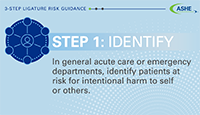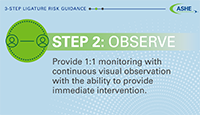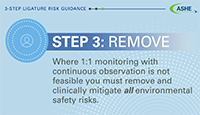Patient Safety Tools and Resources: Preventing Self Harm and Ligature Risks
Hospitals and health systems are working to address the environmental risks associated with the care of patients at risk for suicide and self-harm. The Centers for Medicare & Medicaid Services (CMS) is currently creating comprehensive interpretive guidance, which will incorporate Joint Commission patient safety recommendations. To help hospitals and other health care facilities understand and implement these recommendations, ASHE is developing tools and resources for members.
Key Resources

ASHE On Demand: 2019 Q2–Just ASK ASHE High Risk Video Monitoring
- ASHE Patient Safety and Ligature Identification Checklist – ASHE members can use this tool to create ligature-resistant environments when 1:1 continuous observation is not practical.

- ASHE On Demand: A Safe Health Care Environment
This recording focuses on the process of risk assessment and mitigation of behavioral health patient safety physical risks

ASHE Virtual Rounding Tools

- ASHE Advocacy Repport
- August 2019: CMS to use Joint Commission guidance on preventing self-harm
- April 2019: Ligature Risk Interpretive Guidelines
- Joint Commission expert panel recommendations
- CMS Survey & Certification memos
- August 2018: CMS Clarification of Psychiatric Environmental Risks
- December 2017: Clarification of Ligature Risk Policy
- ASHE Monograph: Converting Medical/Surgical Units for Safe Use by Psychiatric Patients: The Physical and Fiscal Risks, by James M.Hunt, and David M. Sine
Three-step ligature risk guidance for general acute care or emergency departments
ASHE recommends a three-step approach to managing ligature risks and preventing patient self-harm in general acute care or emergency departments. These steps do not apply for psychiatric units.

Step 1: Identify
Identify patients who are currently at risk for intential harm to themselves or others. Steps 2 and 3 only need to be taken with patients who are identified as a risk.

Step 2: Observe
Provide 1:1 monitoring of at-risk patients with continuous visual observation. The person observing the patient needs to be able to intervene immediately. Video observation is not appropriate since the video monitoring process cannot provide immediate intervention.
Some states require privacy in certain situations, such as when the patient is using the bathroom. In these instances, since 1:1 observation is not possible, the bathroom used by the patient must be ligature resistant. Converting a bathroom to a ligature-resistant environment can affect fire and life safety regulations and ADA compliance issues. Health care organizations should conduct a careful review of the rules and regulations that apply to their specific facilities.

Step 3: Remove
In any cases where 1:1 continuous observation is not feasible, hospitals must remove or clinically mitigate all environmental risks. Loose items should be removed from the patient area. Fixtures installed in the room do not need to be removed; however, patient access to certain areas may need to be restricted to prevent patients from reaching items that they could use for self-harm.
